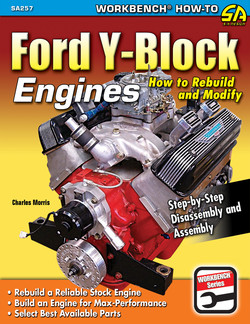Читать книгу Ford Y-Block Engines - Charles Morris - Страница 9
На сайте Литреса книга снята с продажи.
ОглавлениеCHAPTER 2
PULLING THE ENGINE
After you have conducted a thorough inspection and evaluation of the engine, you know whether it needs to be rebuilt or not. Almost all engine analysis can be done with the engine in the chassis. At this stage, you’ve determined that the engine does indeed need a rebuild and must be pulled from the chassis, so proper planning and preparation is a must.
Keep in mind that you are about to jack up a vehicle weighing nearly two tons, disconnect lines carrying hazardous and potentially flammable liquids, and ultimately lift an engine that weighs more than 600 pounds. Make sure the vehicle is on a level surface. You should get some help to perform this procedure so you can safely and carefully remove the engine from the chassis. A good arrangement is to have one person spot the engine and steady it, while the other operates the engine hoist. You may jack up your car during the engine rebuilding process but do not work under the car when it’s only supported by a floor jack. You need to have jack stands at each corner of the vehicle if you’re working under it. Always chock the wheels so your car doesn’t move. If you are removing the engine and transmission together as a unit, now is the time to remove the driveshaft, transmission linkages, speedometer cable, and neutral safety switch wiring.
Hood
Removing the hood provides additional working room and light, so I do this early in the process. Taking the hood off and safely stowing it is a two-person job at minimum. I recommend using old blankets to pad the area of the cowl vent, which is at the back of the hood in front of the windshield. Also use covers on both fenders to protect the paint.
Battery
Loosen the bolts that secure the battery cables to the terminals, and remove the cables. You should remove the battery from the car and store it in a safe place, keeping it out of the way of an errant swing of the engine as it is lifted from the car. Safely store the battery on a plastic or wood shelf where it is not exposed to extreme temperatures. This could ruin the battery.
You need to methodically and carefully examine the top end of the engine. Look for telltale signs of wear and damage, such as oil seeping between the head and the block. This indicates a blown head gasket. Carefully look at the rocker arms, springs, and keepers. If you see a collapsed spring, catastrophic engine damage may have occurred.
Fluids
A Y-block (and any other gas engine) contains hazardous, flammable fluids and chemicals that need to be properly disposed of before you start the rebuild process. After you have drained the oil, radiator fluid, transmission, and possibly power steering fluid from your vehicle, make sure they are properly recycled.
Oil
The typical Y-block engine holds 6 quarts of oil so make sure your drain pan has more than enough capacity. You can drain the oil with the engine in the car or on an engine stand. If you drain the oil with the engine in the car, make sure the car is properly supported by ramps or jack stands.
After draining the oil, inspect it. If it’s golden and clear, the oil is relatively fresh. If it’s black, you know it’s old, but look for metal shavings or anything else unusual. If it’s milky or discolored, most likely coolant mixed with the oil. You could have a cracked block or another problem.
Radiator
In some applications, you may need to remove the fan shroud before you can remove the radiator from its mounts in the core support. Starting at the front of the engine, remove bolt-on parts, the fan, drive belts, and the generator or alternator. Use tags and a Sharpie to mark the location of the wires before you disconnect them. This helps determine the location of the wires during the reassembly process and the position of the power steering pump (if applicable).
A 5-gallon bucket or large multi-gallon drain pan is good for this job. Keep in mind that opening the radiator petcock does not allow all the coolant to drain from the block. This has to be dealt with separately. If there is no petcock in the side of the block, remove the lower radiator hose, which allows most of the coolant to drain.
The old rubber hoses often become stiff and brittle. After many heat cycles, they may be almost bonded to the outlet of the radiator. Place a small flathead screwdriver under the lip of the hose, and run it around the circumference of the hose end. Squeeze the hose, and work it back and forth until it comes loose. If that doesn’t work, you may have to cut it off with a utility knife.
Once the coolant has been drained into the catch bucket or pan, transfer it to a clean container, such as a one-gallon milk jug. Do not mix the coolant with oil or any other chemical. Many oil change outfits and auto parts stores recycle these chemicals for free but not if they are mixed together.
Power Steering
